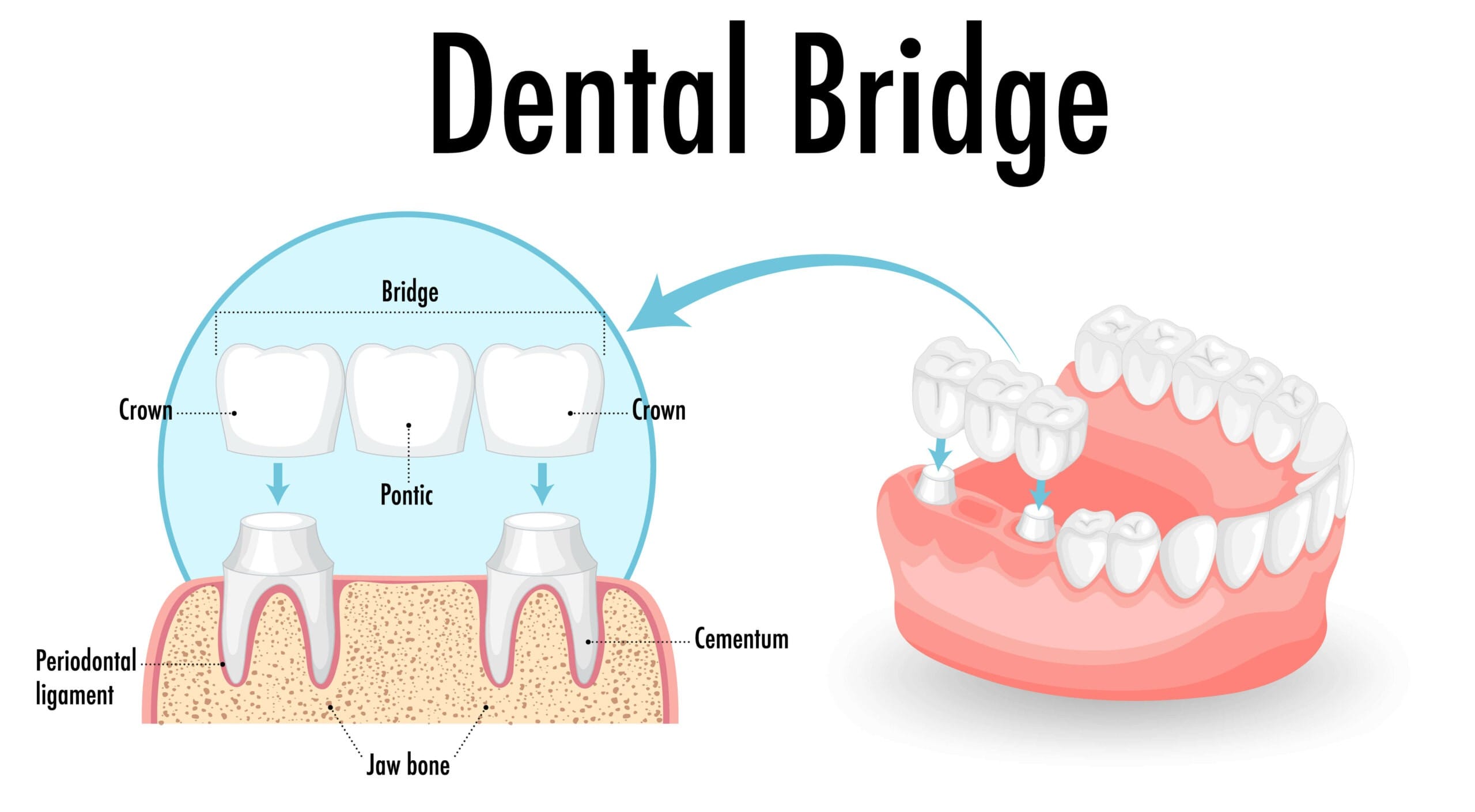DENTAL BRIDGES: CAN A BRIDGE FIX A GAP
If you have missing or lost teeth, dental bridges can effectively restore your smile by filling the gap between them with false or artificial teeth. A dental bridge or pontic consists of a set of false teeth that are anchored by abutment teeth on either side of the gap.
A dental bridge also keeps the loosened adjacent teeth in place and prevents their unnecessary drifting and dislocation. The dental bridges improve the functionality of your teeth and provide you with a natural-looking smile.
Dental bridges are generally recommended to people who have:
- One or more fallen or lost teeth.
- Have good oral health.
- Problems in chewing abilities.
- Two healthy or strong teeth on either side of the lost teeth provide support.
- Have gums free from any kind of oral disease.
The most common material for dental bridges is porcelain because it completely blends with the original colour of your teeth and looks aesthetically pleasing. Some people also go for dental bridges made from gold or palladium alloy; though they do not match your original teeth’ colour, they are still very durable and long-lasting.
HOW DO DENTAL BRIDGES FILL THE GAPS BETWEEN MISSING TEETH?
If a person has lost or fallen out teeth, he should immediately consult an orthodontist to minimise the risks of misalignment or drifting of the adjacent teeth. When individuals have extracted or fallen out teeth and are in good oral health.
Dentists usually recommend that they should have dental bridges as they can effectively restore their smiles by providing a natural appearance. The placement of dental bridges generally requires two appointments with the dentist.
- In the first appointment, the dentist prepares the teeth on either side of a lost tooth to hold the bridge. After that, he takes an impression of your teeth and sends it to the lab for the preparation of the bridge according to your tooth’s size, colour, and shape.
- Then, the dentist places a temporary crown or bridge on the adjacent prepared teeth. These temporary crowns protect the teeth, but they are not as durable as the permanent bridges and must be taken good care of. They should maintain good oral hygiene and should avoid chewing with temporary bridges.
- The dental bridges take almost two weeks in the preparation process at the laboratory. In the second appointment, the dentist replaces the temporary bridges with permanent and durable ones that look and function just like your original teeth.
- The dentist checks the exact fit of the bridge according to your teeth and then cements them to your original teeth. Afterwards, the dentist concludes this procedure by assessing your chewing and biting abilities. In this process, the dentist ensures that the bridge does not negatively affect your teeth’ functionality.
In addition to filling the empty spaces left by lost teeth, dental bridges also improve teeth functionality by restoring chewing abilities. That’s why it is one of the most popular dental restoration procedures.
TYPES OF DENTAL BRIDGES
The dental bridges efficiently restore your chewing, speaking and biting abilities to a great extent. There are generally three types of dental bridges that people opt for according to their oral conditions and preferences.
1. RESIN-BONDED BRIDGES
These are non-invasive types of bridges, and in the resin-bonded bridge placement process, the enamel is not removed from abutment teeth to make space for them. These are also called Maryland bridges and are not supported by crowns; instead, resin holds the metal or porcelain framework.
The dentists place resin-bonded bridges in a simple procedure as they do not require any modifications in the abutment teeth.
2. TRADITIONAL DENTAL BRIDGES
Traditional dental bridges consist of one or more artificial teeth, rely on dental crowns and are cemented on the healthier adjacent teeth. These are the most common type of bridges and are highly durable. Traditional bridges withstand high chewing forces and provide maximum strength.
3. CANTILEVER DENTAL BRIDGES
The cantilever dental bridges are recommended for individuals who do not have healthy teeth on either side of a lost or missing tooth. These bridges are specifically designed to be supported by a single crown on the side of a missing tooth.
These bridges can last more than five years if a person maintains good oral hygiene. The cantilever bridges usually fill the gaps between molars and premolars and are used for a single missing tooth as a single crown anchors them.
COSTS OF DENTAL BRIDGES
The dental bridge costs differ from region to region and are based on the type and quality of bridges. However, the approximate costs of dental bridges may range between $1000 to $5000. The average costs of traditional bridges are between $2000 to $5000 per pontic. Maryland bridges can cost you around $1500 to $2500.
The implant-supported bridges are the most expensive ones and are suggested for patients with complex oral problems. The costs of implant-supported bridges range from $5000 to $15000.
HOW MANY TEETH CAN THE DENTAL BRIDGES REPLACE?
Dental bridges usually replace one to four lost or extracted teeth. Dental bridges restore your appearance and blend with the aesthetics of your original teeth and are the most suitable choice if a patient has healthy abutment teeth on either side of a missing tooth.
IS THE DENTAL BRIDGE PROCEDURE PAINFUL?
The dental bridge placement procedure is not painful at all. During this process, the patients are under anaesthetic and do not feel any pain sensations. However, after getting dental bridges, patients might feel slight discomfort or pain sensations, but these are temporary factors and fade away on their own.
AFTER TOOTH EXTRACTION, HOW LONG SHOULD YOU WAIT FOR THE PLACEMENT OF DENTAL BRIDGES?
After taking your oral impression, the dental bridges are prepared within two to three weeks, but when you get your tooth extracted, you should wait at least five to six months so that your gums stabilise their shape to support the bridges.
Once you get dental bridges, you can eat anything you want, just like your original teeth. However, people need to take care of their dental bridges by maintaining good oral hygiene so that they can last longer.
HOW LONG DO DENTAL BRIDGES LAST?
Dental bridges can last for five to seven years, at the very least. The bridge might endure more than ten years with appropriate oral care and regular expert cleanings.
COST OF DENTAL BRIDGES IN CANADA?
Teeth bridges range in price. The type of bridge you have and where you reside will determine this. Dental insurance often covers a portion of the dental bridge cost Canada if you have it. Depending on your particular dental plan, coverage may vary.












